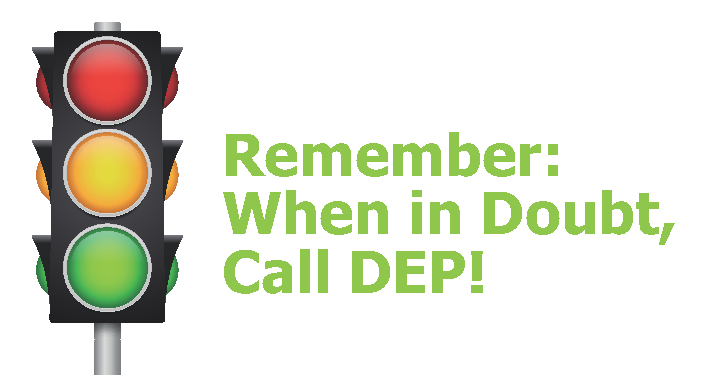Flooding and Storm
Resources
Below you’ll find essential information, resources, and contact details to guide you through every phase of flood and storm preparedness, response, and recovery.
Guidelines for Maintaining Streams in Your Community

DEP strives to assist Pennsylvania communities experiencing the damage and disruption that flooding can cause. This webpage contains resources to help municipal officials, property owners, and others affected by flooding of local streams to better understand the regulatory requirements that apply to working in streams. When stream maintenance work is performed in a well-planned, environmentally responsible manner, the likelihood of future problems is reduced.
Guidelines for Maintaining Streams in Your Community – Booklet (PDF)
Follow our Stoplight Guidance for Flood and Storm Recovery
During recovery, check below to see which actions you can take on your own and which will require you to contact DEP first.
Accordion
Expand AllClick here for a more accessible version

| Proceed - These actions do not require DEP notification, pre-approval, or permits: - Removing non-native (manmade) material, such as litter and construction debris, from the stream, banks, and riparian areas
- Removing woody debris, such as trees, logs, or brush, from the stream while you are standing in the stream (this includes the use of hand-held equipment, such as chainsaws, but not heavy equipment)
- Removing woody debris from the stream while you are standing on the bank (this includes the use of heavy equipment, so long as it remains on the bank and is "picking out" the material and not digging into the streambed)
- Chaining or winching large woody debris and dragging it from the streambank
- Cutting trees off at the stump (keeping the stumps helps stabilize the bank)
- Cleaning out culverts
- Removing gravel and flood debris from around bridges and culverts according to the terms of your permit (contact DEP or your County Conservation District to review your permit conditions)
- Planting trees and other plants on streambanks and in riparian areas, especially native species
- Adopting or implementing stormwater management ordinances and best management practices
- Crossing the stream to access your property immediately after a flood emergency (but only if the conditions are safe)
|

| Contact DEP - These actions likely require DEP notification, verbal pre-approval, emergency permits, or other permits. For projects that pose an imminent threat to life, property, or the environment, such permissions are usually readily obtained.
Call DEP before you begin: - Rebuilding roads and bridges across streams
- Streambank stabilization projects
- Armoring streambanks with an engineered riprap design in emergency situations
- Removing gravel bars from the stream channel using heavy equipment (gravel must be safely relocated out of the floodplain to an upland area that is not a wetland)
- Repairing a bridge or culvert
- Removing a bridge or culvert in danger of failure, or in partial or complete collapse (if a bridge or culvert is no longer serviceable, it can be considered debris and removed)
|

| Contact DEP - These actions definitely require permits, if allowed at all, and may require the involvement of the US Army Corps of Engineers or other agencies.
Call DEP before you begin: - Redirecting the flow of a stream by reshaping gravel bars, or moving gravel to the streambank
- Armoring streambanks with concrete, construction debris, and other impervious materials
- Moving (relocating) a stream
- Dredging streams
- Creating dikes
- Damming streams
- Building a new bridge or culvert
|

Contact DEP for Assistance
During a flooding event, DEP's regional offices may be equipped with well water test kits to distribute at no cost to residents.
The Waterways and Wetlands Programs for each region can be reached at:

FEMA/PEMA Assistance
Citizens should contact FEMA for general flood-related assistance.
Storm and Flood Recovery Fact Sheets and Information